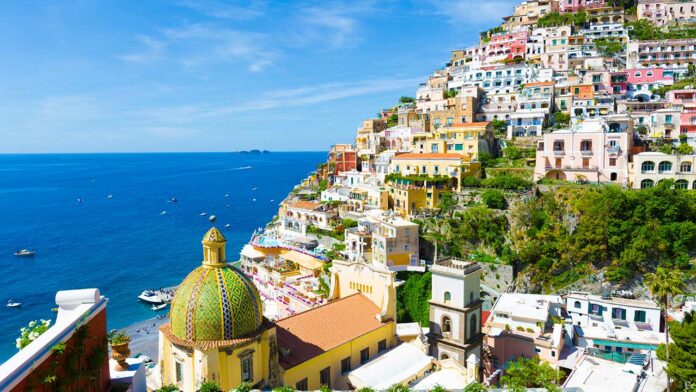A place dear to the international star system, but actually already loved by the ancient Romans, Positano is a perfect mix of natural and architectural beauty, which leaves you breathless thanks to its unforgettable colors.
Positano, known as “The Divine” is one of the most popular and frequented destinations not only of the Amalfi Coast, but throughout Italy. Declared Unesco World Heritage Site, is located about 75 minutes from Naples and 20 from Sorrento. It was already a favorite holiday resort of the ancient Romans, but it experienced its golden season after World War II, when it was transformed from a poor fishing village into the favorite destination of artists and celebrities.
Seen from the sea, Positano resembles a surrealist painting painted in pastel colors: it is a vertical village, which can be practically covered only on foot, among steep stairways and winding paths, with its colorful houses clinging to the rock, among which stands out the colored majolica dome of the Church of S. Maria Assunta. This sacred place, symbol of the village, preserves the legendary Byzantine icon of the Black Madonna, still object of cult and veneration. Among the architectural beauties of the place there are also some ancient defensive towers, almost all of which are still well preserved, such as the Torre della Sponda, dating back to the 13th century, now used as a dwelling. An incredible testimony of the ancient past of Positano is the Villa Romana, located right in the center. Discovered by chance during the works carried out in the crypt of the Church of Santa Maria Assunta, it dates back to a period between the first century B.C. and the first century A.D. and represents one of the most evocative hypogeal archaeological spaces of Roman age discovered in the last years in southern Italy. The building boasts porticoes still in excellent condition, a peristyle and a septum wall decorated with extraordinary polychrome frescoes in Pompeian style. Today it houses the MAR, the Roman Archaeological Museum, in whose rooms it is possible to retrace the entire history of Positano, through multimedia equipment of the latest generation.
The numerous beaches of Positano and its surroundings do not disappoint lovers of the sea: the Spiaggia Grande, with its 300 meters long, is the social heart of the village, meeting place for locals and tourists, thanks to the many clubs frequented by celebrities and international stars. For this reason in the summer months it could be a bit crowded. If you prefer a more relaxing situation, the nearby Fornillo beach is the one for you. Or, if you really want to enjoy an afternoon of total relaxation, know that from the beach of Marina Grande small boats depart to paradisiacal coves reachable only by sea. Off the coast of Positano, then, you will find one of the most beautiful places in the Mediterranean: the so-called Isole delle Sirene (Mermaid Islands). The small archipelago of Li Galli, formed by three islets, considered the refuge of the sirens described in the Odyssey, who with their singing bewitched sailors inevitably making them lose control of their ships, is still almost untouched. Belonged in the last century to various private individuals, including the Russian dancer Rudolf Nureyev, the archipelago can be visited only by invitation. One must be content to approach it by sea, renting a rubber dinghy or booking one of the many excursions departing daily from Positano or Sorrento.
Finally, how to leave Positano without buying (at least) a pair of handmade leather sandals? These traditional Franciscan-style shoes, which have been handmade by master shoemakers here for years, have conquered international divas such as Jackie Onassis and Brigitte Bardot.










